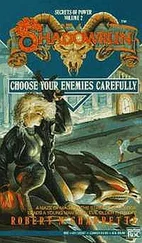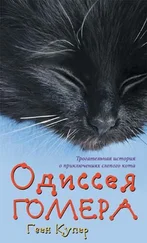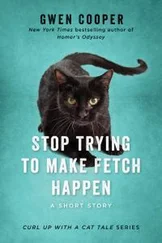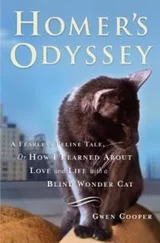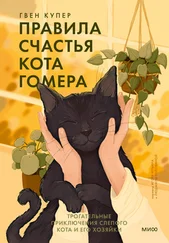I’d been blessed (or cursed, depending on Miami’s up-and-down humidity) with an extraordinarily full head of hair—enough that I hadn’t noticed from one day to the next as bits of it had begun to disappear. But now, disbelieving at first, I reached around and felt what I realized was a decidedly thinning patch on the back of my head.
I told myself to stay calm. After all, was it even possible for one smallish kitten to chew a bald spot right into a person’s scalp?
With mounting horror—as I clutched at a limp clump of wispy strands that had, only recently, been a thick tangle of curls—I decided that, yes . . . yes, it was.
“ Oye! ” I cried. “ No se hace! ” (Jorge and his family disciplined their own cats in Spanish, and I’d fallen into the habit myself.) “ Malo gato! ” I shouted. “ MALO GATO! ”
Startled, Scarlett leapt from the couch and I chased her, trying to wrest the lock of my hair from her mouth. Obviously I didn’t think I could stick it back on, but at least I could stop her from swallowing it, if that was indeed her plan. After about three minutes of pursuit—she nimbly evading my grasp, I feeling more than a little ridiculous to be lumbering so ineffectually after a kitten, for crying out loud—she darted under the bed and out of my reach.
She emerged a little while later but ignored me for the rest of the day, not even bothering with the litany of complaints she usually took up around twenty minutes before her dinnertime. The small pot of cat grass I bought the next day—as a more suitable source of fiber, as well as a gesture of reconciliation ( like an erring husband coming home with flowers , I thought wryly)—remained untouched.
* * *
Strict honesty compels me to say that there actually was one game Scarlett enjoyed playing with me—although describing it that way requires loose definitions of the words game, play, and with. The “game,” such as it was, consisted of Scarlett hiding behind a table leg, or underneath the couch or bed, and leaping out at me as I walked past. She’d hurl herself at my ankles, latching on with her teeth and front claws while her back claws kicked at me furiously, “bunny feet” style, until she drew blood, or I tripped and fell, or both.
I wore heels to work every day. I didn’t have the greatest balance in them, and I was always terrified when Scarlett jumped at me that a pointy heel might inadvertently puncture her head or vulnerable belly. In the process of trying to quickly shuffle my feet away from Scarlett and remain upright at the same time, it wasn’t at all unusual for me to end up tumbling to the ground, falling heavily against whatever piece of furniture Scarlett had just jumped out at me from. I bruised rather easily, and my arms, shoulders, and chest were soon spotted with incriminating black-and-blue marks.
It couldn’t really be said that Scarlett played this game of hers “with” me, because if I made any attempt to touch or even look at her, the game was immediately over, and off she’d run. And even describing it as “play” seems inapt, because Scarlett’s surprise attacks didn’t feel playful so much as . . . mean-spirited. How else could I describe it? Whenever I hit the tiled floor of our apartment with a loud “Oof!” I always sensed that Scarlett was enjoying a silent kitten laugh at my expense. It’s funny when humans fall down!
Still, I was pathetically pleased at receiving even this much attention from my otherwise aloof feline. Like her complaining, this was something else Scarlett did only with me—never with Jorge. Maybe it was true, I reflected (trying not to notice how desperately I was grasping at straws), that you only hurt the ones you love.
Things came to a head one day at work. The school-based community service program I ran was considered a crime prevention initiative, and our administrative space—located in a small office park in southwest Miami—had been donated by the Miami police department. Our next-door neighbor was the bomb squad, and I spent many a happy work break in our shared parking lot, watching as the puppies who were being trained to sniff out explosives bonded with their handlers.
On this particular day, I’d taken off my blazer in the heat of a broiling afternoon, and the sleeveless silk top I wore underneath left my battered arms bared. I didn’t really think about it until one of the bomb-squad officers I was friendly with—a six-foot-two wall of muscle named Eddie del Toro—followed me through reception and into my private office as I returned from lunch, closing the door behind him. Startled at this unprecedented behavior, I turned to face him with a question mark clearly written in my raised eyebrows. Eddie took one of my hands gently in his own, looked earnestly into my eyes, and said in a soft, reassuring voice:
“Just tell me his name and where I can find him.”
This has gone far enough , I told myself a few minutes later, as I stalked out to my car to retrieve my discarded blazer. Naturally I’d understood the conclusions Eddie had reached upon seeing my bruises—and why his first thought had been abusive boyfriend and not evil kitten. I’d explained to him about Scarlett, but I’d still had to show off the corroborating itty-bitty claw marks on my ankles, and then exaggeratedly mime tripping over a small cat a few times, before I’d finally been able to send Officer Eddie—laughing and shaking his head—back over to the bomb squad.
Things were getting ridiculous. I didn’t intend to start going around in turtlenecks and wigs to cover up bruises and bald patches inflicted upon me by a kitten , as if I were the hapless heroine in a Lifetime movie. Something about an abusive, emotionally unavailable cat and the woman who couldn’t help loving her anyway. Seduced by a Feline, I thought. A Kitten to Die For: The Scarlett Cooper Story.
I headed to Barnes & Noble after work that evening and bought an advice book about kittens. Once I was home, I turned immediately to the chapter on how to deal with early signs of aggression. The book advised that, should your kitten show a tendency to attack you in overly aggressive play, you should say No! in a firm voice, and then provide the kitten with an appropriate toy as a substitute for your own flesh.
“No!” I said to Scarlett the next time she leapt out at me from under the coffee table. Reaching down carefully to remove her, claw by claw, from around my ankle, I held out one of the neglected toy mice that had been gathering dust in the corners of our apartment these past three months. “ Here ,” I told her firmly, “is your appropriate toy.”
Scarlett looked at the felt mouse in my hand with an air of disdain. Then, with all the offended dignity of a society matron in a state of high dudgeon, she turned her little rump to me and strode away, swishing her tail twice to emphasize her displeasure. This silent treatment lasted until Scarlett’s next surprise attack—which happened about fifteen minutes later.
It was a pattern we repeated four or five times over the course of the night, always with the same results. The book advised that, if all else failed, the best way to break a cat of aggressive habits was simply to ignore her. When she wrapped herself around one of my ankles, I should detach her and then disregard her. I wasn’t to talk to her, pet her, try to engage her in play, or even so much as look at her. There was no worse punishment for a playful young kitten, the book assured me, than being denied interactive play time with her human.
“HA!” I exclaimed when I read this. The next day, I dropped the book off at the Salvation Army donation bin.
Читать дальше


